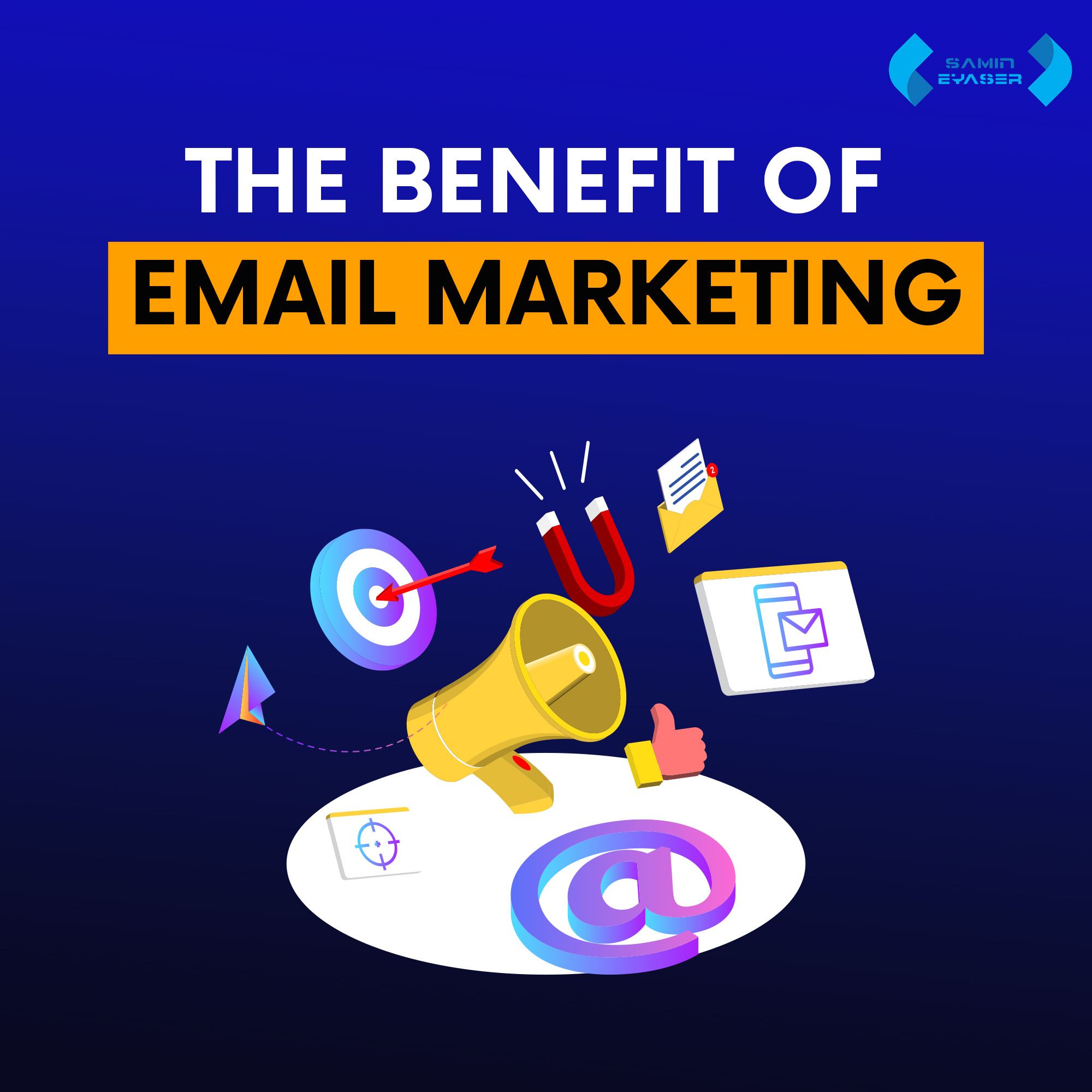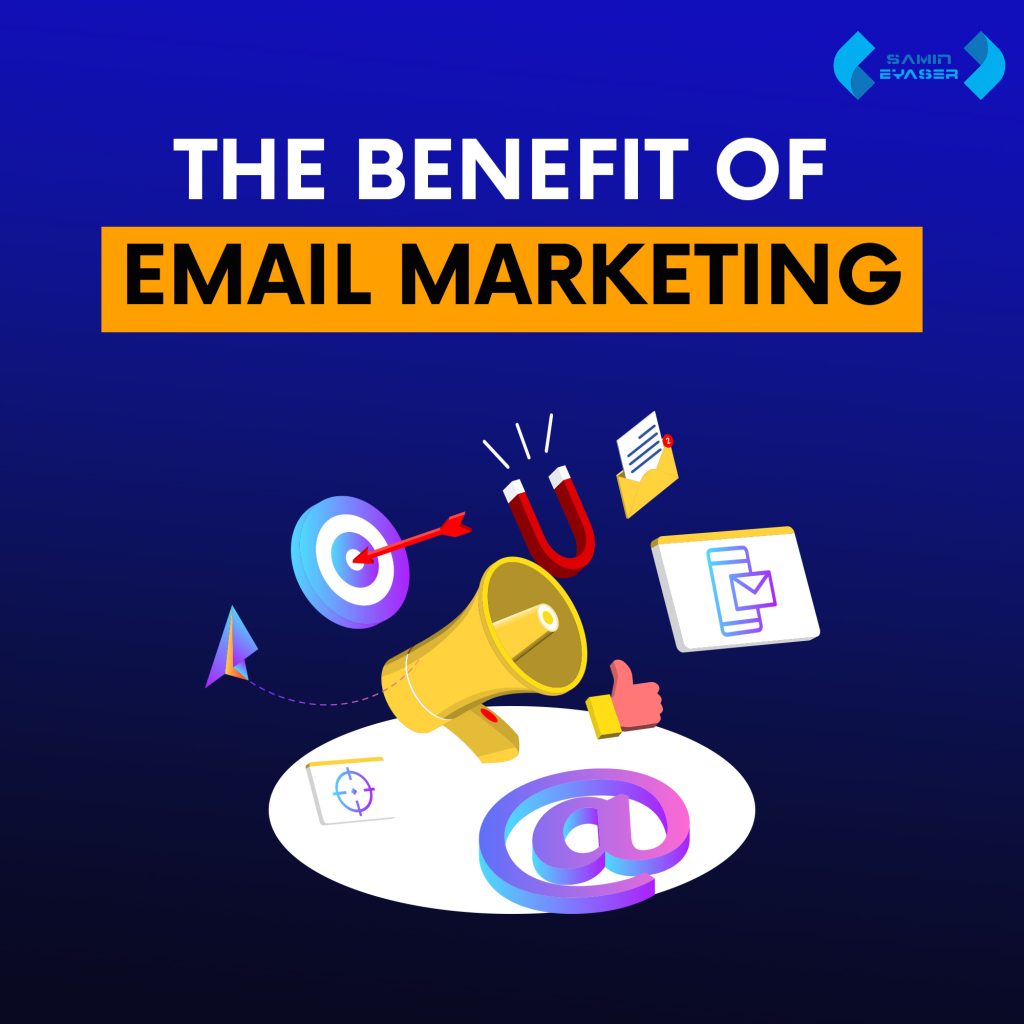Email marketing is a powerful and cost-effective digital marketing strategy that leverages the direct communication channel of email to connect with a targeted audience. It involves sending messages, promotions, or updates to a group of recipients via email, with the aim of building and nurturing relationships, driving engagement, and ultimately, achieving specific business goals. Through personalized and targeted content, email marketing enables businesses to reach their audience with relevant information, promotions, and valuable insights. With the ability to track metrics such as open rates, click-through rates, and conversion rates, email marketing allows for data-driven optimizations, making it a versatile tool for businesses of all sizes to enhance their online presence and customer communication.
The Benefit of Email Marketing
Email marketing has become an indispensable tool in the digital marketing arsenal, proving its worth time and again. In an era dominated by social media and instant messaging apps, one might wonder about the relevance of email marketing. However, the benefits it offers are substantial, making it a cornerstone for businesses aiming to establish a robust online presence.
Definition of Email Marketing
Email marketing is a strategic approach to communicating with a target audience through the use of electronic mail. It involves sending personalized messages, promotions, and valuable content to a group of recipients who have opted to receive such information.
Email marketing’s significance in the digital age
In an age where information overload is the norm, email marketing provides a direct and personalized way to connect with your audience. It allows businesses to cut through the digital noise and engage with their customers on a one-to-one basis.
Advantages of Email Marketing
Email marketing offers numerous advantages for businesses seeking an effective digital outreach strategy. Firstly, it provides a direct and personalized communication channel, allowing companies to tailor messages based on recipient preferences, behaviors, and demographics. This focused strategy raises conversion rates and improves engagement. Additionally, email marketing is cost-effective compared to traditional advertising methods, making it accessible to businesses of all sizes. The ability to track and analyze key metrics, such as open rates and click-through rates, empowers marketers to refine their strategies for better performance. Furthermore, email campaigns can be automated, saving time and effort while maintaining consistent communication with the audience. Overall, the advantages of email marketing lie in its efficiency, affordability, and capacity for precise audience targeting.
Cost-Effectiveness
Email marketing is remarkably economical when looking at marketing methods other than traditional ones. With minimal expenses for design and distribution, businesses can reach a large audience without breaking the bank.
Targeted Communication
One of the significant advantages of email marketing is the ability to tailor messages to specific audience segments. By understanding customer behavior and preferences, businesses can send targeted and relevant content, increasing the likelihood of conversion.
Measurable Results
Unlike traditional advertising, email marketing provides detailed analytics. Businesses can track open rates, click-through rates, and conversion rates, allowing them to measure the success of their campaigns accurately.
Building and Segmenting Email Lists
Building and segmenting email lists are integral steps in creating a successful email marketing strategy. In the initial phase, businesses collect email addresses from interested individuals, website visitors, or customers. This process involves creating engaging sign-up forms, offering incentives, and ensuring compliance with privacy regulations. Once the email list is established, segmentation becomes crucial. Segmenting involves categorizing subscribers based on specific criteria such as demographics, behaviors, or purchase history. This segmentation allows businesses to send targeted and relevant content to specific groups, increasing the likelihood of engagement and conversions. By tailoring messages to the unique needs and preferences of different segments, companies can foster stronger connections with their audience and optimize the impact of their email campaigns. Building and segmenting email lists are key practices for maximizing the effectiveness of email marketing efforts.
Creating Opt-In Lists
Building a permission-based email list is crucial for successful email marketing. Encourage website visitors and customers to subscribe by offering valuable incentives, such as exclusive content or discounts.
Importance of Segmentation
Segmenting your email list based on demographics, behavior, or preferences enables personalized content delivery. This targeted approach enhances engagement and fosters a stronger connection between the brand and the audience
Crafting Compelling Email Content
Crafting compelling email content is an art that involves capturing the audience’s attention and delivering a message that resonates. The key lies in creating content that is not only relevant but also engaging and valuable to the recipients. This includes attention-grabbing subject lines, concise and persuasive copy, visually appealing layouts, and a clear call-to-action. Personalization plays a crucial role, as tailoring content to the interests and preferences of the audience enhances the overall impact. By understanding the needs of the recipients and addressing them effectively, businesses can build trust and foster a positive relationship with their email subscribers. Compelling email content not only encourages higher open and click-through rates but also contributes to the achievement of broader marketing goals, such as increased brand loyalty and customer conversions.
Personalization Techniques
Personalization goes beyond addressing recipients by their names. Utilize customer data to create highly personalized content that resonates with individual preferences, leading to higher engagement and conversion rates.
Attention-Grabbing Subject Lines
Your email’s subject line makes a first impression. Craft compelling and curiosity-inducing subject lines to entice recipients to open your emails and discover the valuable content within.
Incorporating Multimedia
Enhance the visual appeal of your emails by incorporating multimedia elements like images, videos, and GIFs. Visual content captures attention and communicates messages more effectively than plain text
Automation in Email Marketing
Automation in email marketing has revolutionized the way businesses engage with their audience by streamlining processes and enhancing efficiency. This powerful tool allows marketers to set up predefined workflows and trigger emails based on specific actions or time intervals. From welcome sequences and personalized drip campaigns to abandoned cart reminders, automation ensures timely and relevant communication with subscribers. This not only saves valuable time but also enables consistent and targeted messaging, improving overall engagement. Additionally, automation facilitates the tracking of user behavior, enabling businesses to send highly personalized content that aligns with individual preferences. By harnessing the capabilities of automation, companies can nurture leads, strengthen customer relationships, and optimize their email marketing strategies for maximum impact.
Time-Saving Benefits
Email marketing automation allows businesses to streamline repetitive tasks, saving time and resources. Welcome emails, cart abandonment alerts, and customized recommendations are examples of automated workflows.
Creating Effective Email Campaigns
Designing a successful email campaign involves strategic planning. Set clear goals, segment your audience, and create compelling content that guides recipients through the customer journey, from awareness to conversion.
Analyzing Email Marketing Metrics
Analyzing email marketing metrics is a crucial aspect of refining and optimizing campaign performance. Key metrics such as open rates, click-through rates, conversion rates, and bounce rates provide valuable insights into the effectiveness of email campaigns. Open rates indicate the percentage of recipients who have opened the email, while click-through rates measure the engagement level by tracking the number of clicks on links within the email. Conversion rates reveal the proportion of recipients who took the desired action, whether it’s making a purchase or signing up for a webinar. Bounce rates highlight potential deliverability issues. By closely monitoring and interpreting these metrics, businesses can make data-driven decisions, adjust content and strategies, and ultimately enhance the impact of their email marketing efforts. Regular analysis of these metrics ensures continuous improvement and the ability to adapt strategies to meet the evolving needs of the target audience.
Overcoming Email Marketing Challenges
Overcoming email marketing challenges requires a strategic approach and adaptability. One common hurdle is avoiding the spam folder, which emphasizes the importance of maintaining a clean and engaged subscriber list. Another challenge is crafting compelling content that cuts through the clutter of inboxes and resonates with the audience. Personalization becomes crucial in addressing this issue, tailoring messages to individual preferences and behaviors. Additionally, staying compliant with ever-evolving privacy regulations ensures a trustworthy relationship with subscribers. Technological challenges, like optimizing for various devices, demand a responsive design to enhance user experience. Successful email marketers navigate these challenges by embracing innovation, staying informed about industry trends, and consistently refining their strategies to deliver valuable, relevant content to their audience.
Tips for Email Marketing Success
Achieving success in email marketing requires a combination of strategic planning and thoughtful execution. Start by building a high-quality, engaged subscriber list through ethical means. Craft compelling and personalized content that addresses the needs and interests of your audience, paying special attention to attention-grabbing subject lines. Consistency is key, so establish a regular sending schedule that aligns with your audience’s expectations. Embrace segmentation to tailor messages for specific groups, and leverage automation to streamline workflows and enhance efficiency. Regularly analyze key metrics to gain insights into campaign performance and make data-driven adjustments. Stay compliant with privacy regulations and always provide clear and easy ways for subscribers to opt out. Lastly, prioritize mobile optimization to ensure a seamless experience for users on various devices. By implementing these tips, businesses can foster stronger connections with their audience and maximize the impact of their email marketing efforts.
The Future of Email Marketing
The future of email marketing is poised for continued innovation and adaptation to evolving consumer behaviors and technological advancements. Personalization is expected to become even more sophisticated, utilizing artificial intelligence and machine learning to deliver hyper-personalized content tailored to individual preferences. Interactive elements within emails, such as quizzes and polls, are likely to increase engagement by offering a more dynamic and immersive experience. As privacy concerns gain prominence, marketers will need to navigate stricter regulations by prioritizing transparency and obtaining explicit consent from subscribers. Integration with other channels, like social media and messaging apps, will become more seamless, creating cohesive and omnichannel customer experiences. Automation will continue to play a pivotal role, allowing for highly targeted and timely campaigns. Overall, the future of email marketing lies in its ability to adapt, embrace emerging technologies, and prioritize user-centric strategies to maintain its effectiveness in the ever-evolving digital landscape.
Conclusion
In conclusion, email marketing remains a cornerstone of effective digital communication and brand engagement. As we navigate an increasingly dynamic and competitive landscape, the key to success lies in strategic adaptation and innovation. The continued emphasis on personalization, driven by advanced technologies, ensures that marketers can deliver content that resonates with individual preferences. While challenges such as privacy concerns and evolving regulations persist, adherence to ethical practices and transparent communication with subscribers will be paramount. The future holds exciting possibilities, with interactive content, seamless omnichannel integration, and refined automation set to redefine the email marketing landscape. As businesses forge ahead, the enduring value of email marketing lies in its ability to foster meaningful connections, drive conversions, and adapt to the ever-changing needs of a diverse and discerning audience.
Frequently Asked Questions (FAQs)
Q1. How often should I send marketing emails?
Ans: It depends on your audience and industry. Monitor engagement metrics to determine the optimal frequency without overwhelming your subscribers.
Q2. What are the best practices for email personalization?
Ans: Utilize customer data, create segmented lists, and craft personalized content. Strive for a balance between relevance and non-intrusiveness.
Q3. How can I grow my email subscriber list organically?
Ans: Offer valuable incentives, such as exclusive content or discounts, to encourage visitors to subscribe. Leverage social media and website integrations to expand your reach.
Q4. Are there legal considerations in email marketing?
Ans: Yes, adhere to regulations like GDPR and CAN-SPAM. Obtain consent before sending emails and provide easy opt-out options for subscribers.
Q5. What role does storytelling play in email campaigns?
Ans: Storytelling creates a connection with your audience. Use narratives that resonate with your brand and values to evoke emotions and build stronger relationships.
Thanks for visiting our website


